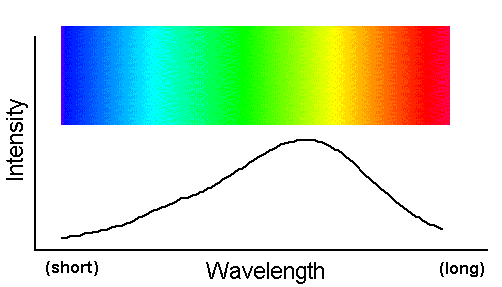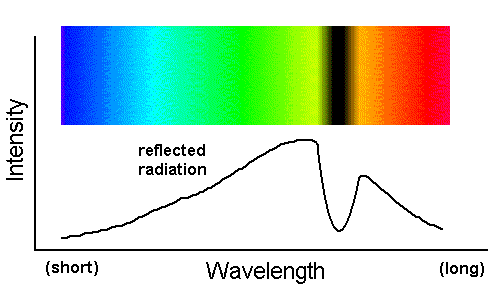Absorption spectra
Another type of spectrum is called an absorption spectrum. This spectrum is of supreme importance to those doing remote sensing. Consider a beam of continuum radiation emitted by some glowing object (like our sun); suppose this beam strikes a solid surface and is reflected. Some of the energy in the beam will be absorbed by the solid surface--the exact wavelengths absorbed and the degree of absorption both depend upon the nature of the reflecting surface. A spectral analysis device would classify the reflected light as an absorption spectrum.
As an elaborating example of the formation of absorption spectra, recall the beam of continuum radiation we talked about on the previous page, i.e.



Since every kind of atom or molecule has its own unique combination of absorption features, it is theoretically possible to use remote sensing of reflected spectra to determine the chemical composition of the surfaces of objects. For example, geologists use remote sensing to classify exposed rock surfaces with great success. Their success is due in part because different minerals have very different absorption features (different minerals can have extremely different chemical compositions).
Botanists have a much more challenging task because the characteristic colors in the leaves of most plants are due to the same small set of pigments. As a result, the spectra of a dark green plant and a light green plant may differ only in the details. Remote sensing practitioners are forced to try to classify vegetation using what at times are the most subtle of spectral differences. To heighten the difficulty even more, factors such as plant maturity, illumination angles, nutrition status, season, etc., can create spectral differences that overlap or even overwhelm the spectral differences between the various species being monitored.
Real spectra are much more complicated than my little cartoons, and are festooned with bumps, dips, valleys, and gorges. Spectroscopists often refer to the spectral dips and wiggles due to (for example) a plant as a spectral signature. The goal is to recognize some combination of features in the spectral signature that are unique to the target objects being mapped.
Note that while I have commented mostly on absorption features created when light reflects off an opaque object, absorption features can also be created when light passes through transparent gases (such as our atmosphere), as we shall discuss more fully in the next section.


